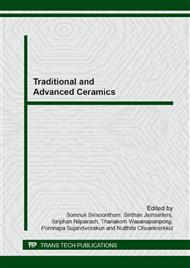p.91
p.97
p.103
p.108
p.114
p.122
p.127
p.132
p.141
Effect of Firing Temperatures on Physical Properties and Phase Evolutions of Fine Stoneware Bodies
Abstract:
Four formulas of the stoneware bodies were formulated with and without an increasing amount of lithium oxide. The bodies were designed to vitrify at the temperature lower than 1150°C. A comparison on the physical properties and the phase formation of the bodies after firing at the temperature of 1100°C, 1150°C, and 1200°C was studied. The experiment results showed that the bodies containing lithium oxide vitrified at lower temperature and showed less variation in water absorption, density, and shrinkage values in the firing range 1100-1200°C. The XRD results showed that, at 1100°C, all the bodies composed of mullite, albite, and quartz. A reduction in the amount of albite and quartz associated with mullite formation was observed when increasing the amount of lithium oxide or the temperature. Furthermore, the body with lithium oxide tended to have higher value of the Modulus of Rupture.
Info:
Periodical:
Pages:
114-121
Citation:
Online since:
April 2014
Keywords:
Price:
Сopyright:
© 2014 Trans Tech Publications Ltd. All Rights Reserved
Share:
Citation:


